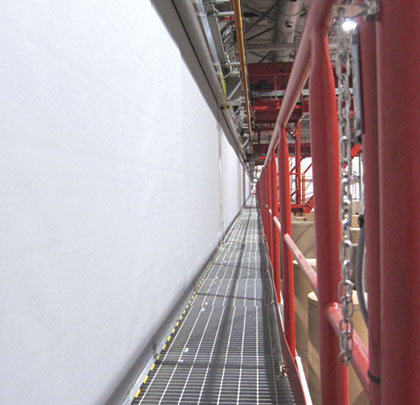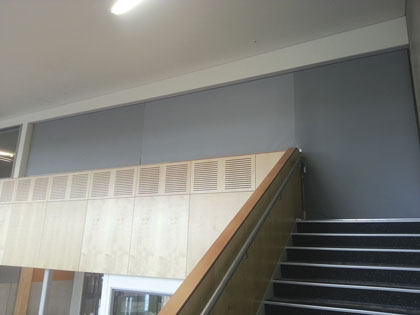Contractors are frequently confused about codes, standards, and appropriate uses of smoke and fire curtains in commercial settings, and they are not alone. Architects, fire safety officials, and building owners have been confounded in recent years by code changes, and the frustration has grown as more businesses have installed or expressed interest in fire and smoke protective curtains.
The BILCO Company of New Haven, Connecticut, a manufacturer of specialty access products and supplier of COLT fire and smoke protective curtains, recently authored a white paper to clear up the confusion. The paper, based on research by code expert Vickie Lovell and Douglas Evans, Fellow of the Society of Fire Protection Engineers, details codes and standards contractors, facility managers, architects, and others involved in building construction need to know about fire and smoke protective curtains. The article also pinpoints applications where curtains can and cannot be used.
HISTORY LESSON
A fire at the Drury Lane theater in London in 1672 led to the development of the world’s first known fire curtain. The owners rebuilt the theater with two fire safety features: a large water tank placed on the roof to douse potential stage fires, and an iron curtain to protect the audience from backstage fires.
A curtain installed at the Iroquois Theater in Chicago did not prevent the deadliest single-building fire in U.S. history, as documented by the National Fire Protection Association, in December 1903. During a performance of the musical Mr. Blue Beard, 602 people died when a fire curtain failed to deploy after it snagged on a light reflector that stuck out under the proscenium arch. The fire started when sparks from a short circuit on an arc light ignited a muslin curtain.
The theater, which opened just a month earlier, did not test the curtain prior to the blaze. The lack of exit signs and emergency lighting, locked exits, and exit doors that opened inward also contributed to the lethal conflagration.
Codes and standards continued to evolve over the years, but were predominantly used in theaters. Engineers and architects in Europe started to discover more applications for fire curtains in the early 1980s, and more U.S. commercial enterprises started to install fire curtains in the early 2000s.
WHAT ARE FIRE CURTAINS
Fire and smoke protective curtains are comprised of a flexible, heat-resistant fabric infused with a coating to limit air infiltration. Curtains limit the effects of unimpeded migration of fire and smoke. They can deploy upon receiving a signal from a smoke protection device, gravity deploy upon a loss of power, or installed in place. They can also be concealed above a ceiling and weighted to assist with deployment and limit deflection caused by air movement. They are not considered an equivalent alternative to a fire-resistant door or wall assembly.
KNOW THE CODES
Underwriters Laboratories and the National Fire Protection Association have several codes that apply to fire curtains. The most critical are UL 10D, UL 1874, and NFPA 80.
UL 10D, which was approved in 2014, evaluates fire protective curtain assemblies intended to provide supplemental, passive fire protection as part of an engineered fire protection system. UL 1784, which was also recently introduced, tests assemblies for air leakage of door assemblies and other protectives. UL 864 addresses requirements for control units and accessories for fire alarm systems.

Fire and smoke protective curtains are comprised of a flexible, heat-resistant fabric infused with a coating to limit air infiltration. Curtains limit the effects of unimpeded migration of fire and smoke. They are not considered an equivalent to a fire-resistant door or wall assembly.
NFPA regulates the installation of maintenance of assemblies and devices used to protect openings in walls, floors, and ceilings against the spread of fire within or into buildings. NFPA 80, Section 21.1.1, clarifies that the current generation of curtain assemblies are not to be confused with fabric fire safety curtains, which are specifically intended for protection of proscenium openings. Fabric fire safety curtain assemblies are part of the passive fire-resistive separation between the stage and the audience seating area. They are intended to provide at least 20 minutes of protection so audiences can safely evacuate. For recognition as proscenium opening protection, curtains must meet the requirements of the 2016 edition of NFPA 80 Chapter 20, which deals specifically with fabric curtains.
WHERE TO USE THEM
With the codes and standards currently in place, compliant applications for curtains include draft curtains for escalators, stair openings, and warehouse storage areas; smoke partitions, including opening protectives; elevator hoist-ways to limit smoke migration; non-egress opening protectives in corridors that require a 20-minute rating and smoke barriers; proscenium openings (provided the curtains also meet the requirements of Chapter 20 of 2016 NFPA 80); and service counter fire doors where 20-minute opening protectives are allowed. A UL Task Group is also considering the inclusion of horizontal sliding applications, which will create even more opportunities to use curtains.
In evaluating where curtains can be used, contractors should consider code compliance, performance and aesthetic characteristics, integration with an engineered smoke control system, and other options. Those options include firefighters’ override, sizing, orientation, guide systems, fabric materials, and siren/strobe light capabilities.
About the Author:
Steve Weyel is a product manager with the BILCO Company and has worked extensively to introduce Colt’s line of natural ventilation and smoke and fire curtains to the U.S. construction market. For a copy of the white paper with complete details about codes and compliant applications, write to BILCO at commercial@bilco.com.
_________________________________________________________________________
Modern Contractor Solutions, December 2017
Did you enjoy this article?
Subscribe to the FREE Digital Edition of Modern Contractor Solutions magazine.




